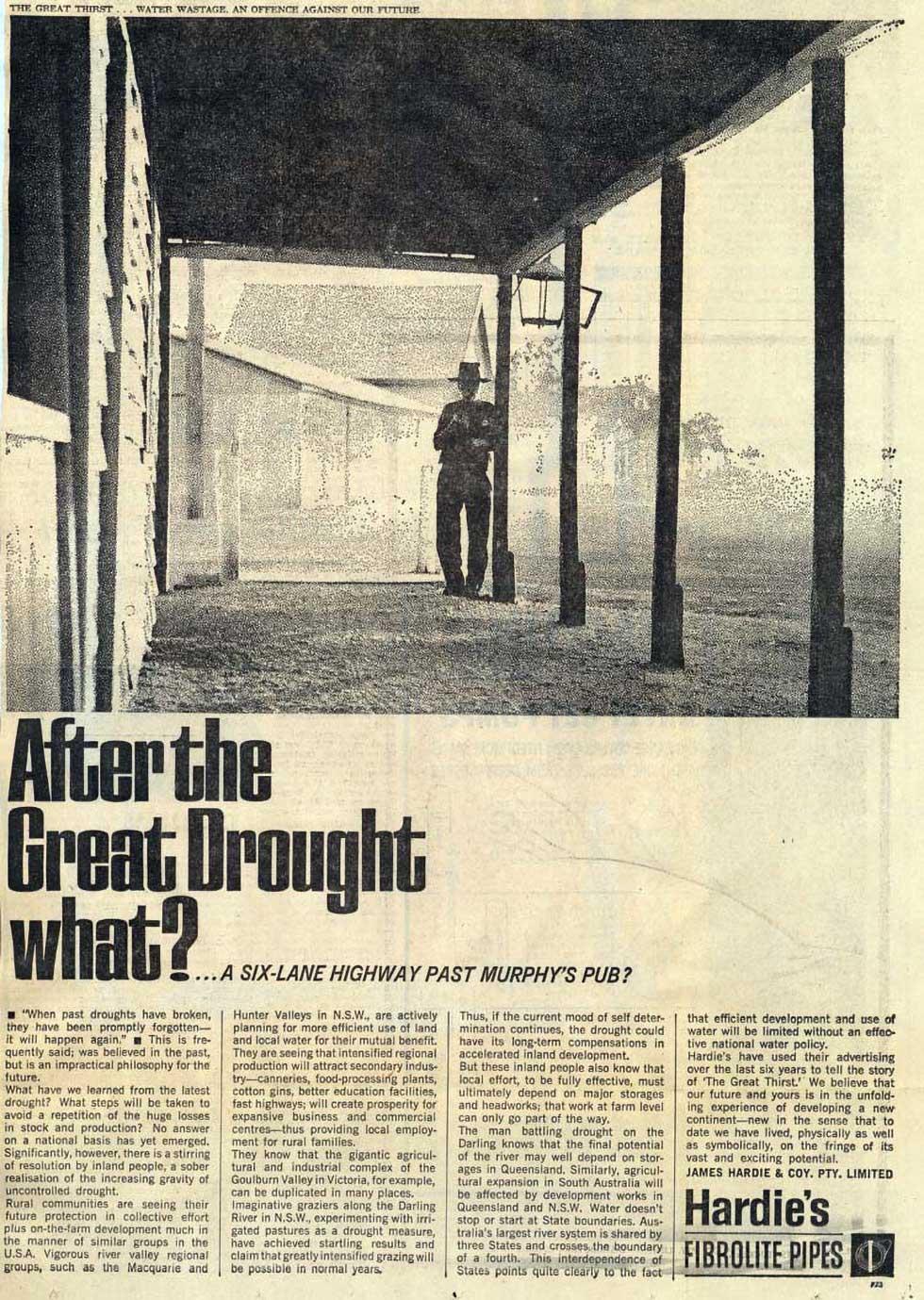
Advertisement for Hardie's Fibrolite Pipes.
Aboriginal and Torres Strait Islander people should be aware that the National Archives' website and collection contain the names, images and voices of people who have died.
Some records include terms and views that are not appropriate today. They reflect the period in which they were created and are not the views of the National Archives.


Advertisement for Hardie's Fibrolite Pipes.
[Small text:] THE GREAT THIRST...WATER WASTAGE. AN OFFENCE AGAINST OUR FUTURE.
[Black and white photo of a man leaning against a verandah post outside a farm building.]
[Headline:] After the Great Drought what?
[Subheading:]...A SIX-LANE HIGHWAY PAST MURPHY’S PUB?
“When past droughts have broken, they have been promptly forgotten – it will happen again.” This is frequently said; was believed in the past, but is an impractical philosophy for the future.
What have we learned from the latest drought? What steps will be taken to avoid a repetition of the huge losses in stock and production? No answer on a national basis has yet emerged. Significantly, however, there is a stirring of resolution by inland people, a sober realisation of the increasing gravity of uncontrolled drought.
Rural communities are seeing their future protection in collective effort plus on-the-farm development much in the manner of similar groups in the U.S.A. Vigorous river valley regional groups, such as the Macquarie and Hunter Valleys in N.S.W., are actively planning for more efficient use of land and local water for their mutual benefit. They are seeing that intensified regional production will attract secondary industry – canneries, food-processing plants, cotton gins, better education facilities, fast highways; will create prosperity for expansive business and commercial centres – thus providing local employment for rural families.
They know that the gigantic agricultural and industrial complex of the Goulburn Valley in Victoria, for example, can be duplicated in many places. Imaginative graziers along the Darling River in N.S.W., experimenting with irrigated pastures as a drought measure, have achieved startling results and claim that greatly intensified grazing will be possible in normal years.
Thus, if the current mood of self determination continues, the drought could have its long-term compensations in accelerated inland development.
But these inland people also know that local effort, to be fully effective, must ultimately depend on major storages and headworks; that work at farm level can only go part of the way.
The man battling drought on the Darling knows that the final potential of the river may well depend on storages in Queensland. Similarly, agricultural expansion in South Australia will be affected by development works in Queensland and N.S.W. Water doesn’t stop or start at State boundaries. Australia’s largest river system is shared by three States and crosses the boundary of a fourth. This interdependence of States points quite clearly to the fact that efficient development and use of water will be limited without an effective national water policy.
Hardie’s have used their advertising over the last six years to tell the story of ‘The Great Thirst.’ We believe that our future and yours is in the unfolding experience of developing a new continent – new in the sense that to date we have lived, physically as well as symbolically, on the fringe of its vast and exciting potential.
JAMES HARDIE & COY. PTY. LIMITED
[Logo for:] Hardie’s FIBROLITE PIPES
Learn how to interpret primary sources, use our collection and more.
